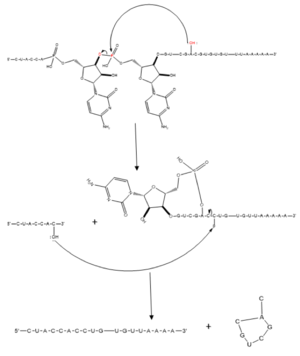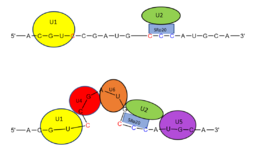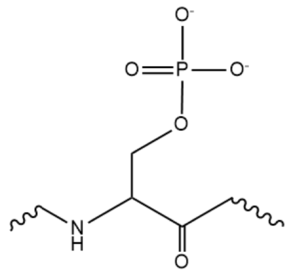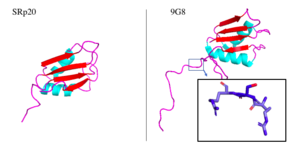User:Neel Bhagat/Sandbox 1
From Proteopedia
| Line 6: | Line 6: | ||
=== History === | === History === | ||
Splicing is one step in the process of RNA maturation that cuts out introns and joins exons together. Both the spliceosome, a complex of snRNAs (U1, U2, etc.), and splicing factors like SRp20 interact with intron consensus sequences in the pre-mRNA to regulate this process. [https://en.wikipedia.org/wiki/Alternative_splicing Alternative splicing] allows one mRNA molecule to produce numerous proteins that perform different functions in a cell by inclusion and exclusion of RNA sequences. There are two main families of splicing factors: Serine-Arginine rich (SR) proteins and heterogeneous nuclear RiboNucleoProteins ([https://en.wikipedia.org/wiki/Heterogeneous_ribonucleoprotein_particle hnRNPs]). | Splicing is one step in the process of RNA maturation that cuts out introns and joins exons together. Both the spliceosome, a complex of snRNAs (U1, U2, etc.), and splicing factors like SRp20 interact with intron consensus sequences in the pre-mRNA to regulate this process. [https://en.wikipedia.org/wiki/Alternative_splicing Alternative splicing] allows one mRNA molecule to produce numerous proteins that perform different functions in a cell by inclusion and exclusion of RNA sequences. There are two main families of splicing factors: Serine-Arginine rich (SR) proteins and heterogeneous nuclear RiboNucleoProteins ([https://en.wikipedia.org/wiki/Heterogeneous_ribonucleoprotein_particle hnRNPs]). | ||
| - | The SRp20 protein belongs to the SR protein family. All SR proteins are defined by a RNA-binding domain at the N-terminus and a serine-arginine rich domain at the C-terminus<ref>[ | + | The SRp20 protein belongs to the SR protein family. All SR proteins are defined by a RNA-binding domain at the N-terminus and a serine-arginine rich domain at the C-terminus<ref>[10.1101/gad.6.5.837]</ref>. The discovery of this family started in the 1900s with the [https://en.wikipedia.org/wiki/Serine/arginine-rich_splicing_factor_1 SF2] (SRp30a) protein and has since come to include twelve proteins, all of which act as splicing factors. SRp20 was first discovered in calf thymus when it was separated with several other SR proteins based on their molecular weight<ref>doi: 10.1101/gad.6.5.837</ref>. |
An identical protein, called [http://www.uniprot.org/uniprot/Q9V3V0 X16], was discovered in an earlier paper studying different genes that change expression during [https://en.wikipedia.org/wiki/B_cell B-cell] development<ref>[https://doi.org/10.1016/S0168-9525(01)02626-9]</ref>. At the time, the protein was assumed to play a role in RNA processing and cellular proliferation, a finding that was later proved to be true<ref>[https://doi.org/10.1093/nar/19.6.1273]</ref><ref>[https://doi.org/10.1016/S0168-9525(01)02626-9]</ref>. | An identical protein, called [http://www.uniprot.org/uniprot/Q9V3V0 X16], was discovered in an earlier paper studying different genes that change expression during [https://en.wikipedia.org/wiki/B_cell B-cell] development<ref>[https://doi.org/10.1016/S0168-9525(01)02626-9]</ref>. At the time, the protein was assumed to play a role in RNA processing and cellular proliferation, a finding that was later proved to be true<ref>[https://doi.org/10.1093/nar/19.6.1273]</ref><ref>[https://doi.org/10.1016/S0168-9525(01)02626-9]</ref>. | ||
The SRp20 protein has been shown to play a role in cancer progression and neurological disorders, specifically through alternative splicing. For example, SRp20 has been shown to play a role in alternative splicing of the Tau protein, an integral protein in the progression of Alzheimer’s disease<ref>[https://doi.org/10.1093/nar/19.6.1273]</ref>. SRp20 has even been found to serve as a splicing factor for its own mRNA, influencing the inclusion of exon 4<ref>[https://doi.org/10.1093/nar/19.6.1273]</ref>. Another function of SRp20 is its role in export of mRNA out of the nucleus, notably [https://en.wikipedia.org/wiki/Histone_H2A H2A histone] mRNA export<ref>[10.1038/sj.emboj.7601385]</ref>. | The SRp20 protein has been shown to play a role in cancer progression and neurological disorders, specifically through alternative splicing. For example, SRp20 has been shown to play a role in alternative splicing of the Tau protein, an integral protein in the progression of Alzheimer’s disease<ref>[https://doi.org/10.1093/nar/19.6.1273]</ref>. SRp20 has even been found to serve as a splicing factor for its own mRNA, influencing the inclusion of exon 4<ref>[https://doi.org/10.1093/nar/19.6.1273]</ref>. Another function of SRp20 is its role in export of mRNA out of the nucleus, notably [https://en.wikipedia.org/wiki/Histone_H2A H2A histone] mRNA export<ref>[10.1038/sj.emboj.7601385]</ref>. | ||
| Line 54: | Line 54: | ||
<references/> | <references/> | ||
| - | 1. <ref>[https://doi.org/10.1016/j.bbrc.2013.05.027]</ref> | + | 1. Corbo C, Orrù S, and Salvatore F. 2013. “SRp20: An overview of its role in human diseases.” Biochemical and Biophysical Research Communications; 436(1):1-5.<ref>[https://doi.org/10.1016/j.bbrc.2013.05.027]</ref> |
| - | 2. <ref>[10.1101/gad.6.5.837]</ref> | + | 2. Zahler, A. M., Lane, W. S., Stolk, J. A., & Roth, M. B. 1992. “SR proteins: a conserved family of pre-mRNA splicing factors.” Genes & development; 6(5):837-847.<ref>[10.1101/gad.6.5.837]</ref> |
3. <ref>[https://doi.org/10.1093/nar/19.6.1273]</ref> | 3. <ref>[https://doi.org/10.1093/nar/19.6.1273]</ref> | ||
| - | 4. <ref>[10.1038/sj.emboj.7601385]</ref> | + | 4. Hargous Y, Hautbergue GM, Tintaru AM, Skrisovska L, Golocanov AP, et. al. 2006. “Molecular basis of RNA recognition and TAP binding by the SR proteins SRp20 and 9G8.” The EMBO Journal; 25(21):5126-5137. <ref>[10.1038/sj.emboj.7601385]</ref> |
| - | 5. <ref>[https://doi.org/10.1016/S0168-9525(01)02626-9]</ref> | + | 5. Cáceres JF and Kornblihtt AR. 2002. “Alternative splicing: multiple control mechanisms and involvement in human disease.” TRENDS in Genetics; 18(4):186-193. <ref>[https://doi.org/10.1016/S0168-9525(01)02626-9]</ref> |
6. <ref>[https://doi.org/10.1016/S1097-2765(03)00089-3]</ref> | 6. <ref>[https://doi.org/10.1016/S1097-2765(03)00089-3]</ref> | ||
| - | 7. <ref>[https://doi.org/10.1186/gb-2009-10-10-242]</ref> | + | 7. Shepard, P. J., & Hertel, K. J. 2009. “The SR protein family.” Genome biology; 10(10):242.<ref>[https://doi.org/10.1186/gb-2009-10-10-242]</ref> |
| - | 8. <ref>[10.1002/pmic.201100370]</ref> | + | 8. Corbo C, Orrù S, Gemei M, Di Noto R, Mirabelli P, et. al. 2012. “Protein cross-talk in CD133+ colon cancer cells indicates activation of the Wnt pathway and upregulation of SRp20 that is potentially involved in tumerigenicity.” Proteomics; 12(12):2045-2059. <ref>[10.1002/pmic.201100370]</ref> |
| - | 9. <ref>[21179588]</ref> | + | 9. Jia R, Li C, McCoy JP, Deng C, and Zheng Z. 2010. “SRp20 is a proto-oncogene critical for cell proliferation and tumor induction and maintenance.” International Journal of Biological <ref>[21179588]</ref> |
| - | 10. <ref>[10.1083/jcb.143.3.777]</ref> | + | 10. Ebneth A, Godemann K, Stamer S, Illenberger B, Trinczek E, et. al. 1998. “Overexpression of Tau Protein Inhibits Kinesin-dependent Trafficking of Vesicles, Mitochondria, and Endoplasmic Reticulum: Implications for Alzheimer’s Disease.” Journal of Cell Biology; 143(3):777-794. <ref>[10.1083/jcb.143.3.777]</ref> |
| - | 11. <ref>[https://doi.org/10.3389/fgene.2015.00142]</ref> | + | 11. Naro C, Bielli P, Pagliarini V, and Sette C. 2015. "The interplay between DNA damage response and RNA processing:the unexpected role of splicing factors as gatekeepers of genome stability." Frontiers in Genetics; 5(12):1-10.<ref>[https://doi.org/10.3389/fgene.2015.00142]</ref> |
Revision as of 04:04, 3 April 2018
Introduction
Overview
The SRp20 protein is an alternative splicing factor found in homo sapiens as well as many other eukaryotes. It is a relatively small protein with a length of 164 amino acids and a weight of about 19kDa. In fact, it is the smallest member of the SR protein family. The protein contains two domains: a serine-arginine rich (SR) domain and a RNA-recognition domain (RRM)[1].
History
Splicing is one step in the process of RNA maturation that cuts out introns and joins exons together. Both the spliceosome, a complex of snRNAs (U1, U2, etc.), and splicing factors like SRp20 interact with intron consensus sequences in the pre-mRNA to regulate this process. Alternative splicing allows one mRNA molecule to produce numerous proteins that perform different functions in a cell by inclusion and exclusion of RNA sequences. There are two main families of splicing factors: Serine-Arginine rich (SR) proteins and heterogeneous nuclear RiboNucleoProteins (hnRNPs). The SRp20 protein belongs to the SR protein family. All SR proteins are defined by a RNA-binding domain at the N-terminus and a serine-arginine rich domain at the C-terminus[2]. The discovery of this family started in the 1900s with the SF2 (SRp30a) protein and has since come to include twelve proteins, all of which act as splicing factors. SRp20 was first discovered in calf thymus when it was separated with several other SR proteins based on their molecular weight[3]. An identical protein, called X16, was discovered in an earlier paper studying different genes that change expression during B-cell development[4]. At the time, the protein was assumed to play a role in RNA processing and cellular proliferation, a finding that was later proved to be true[5][6]. The SRp20 protein has been shown to play a role in cancer progression and neurological disorders, specifically through alternative splicing. For example, SRp20 has been shown to play a role in alternative splicing of the Tau protein, an integral protein in the progression of Alzheimer’s disease[7]. SRp20 has even been found to serve as a splicing factor for its own mRNA, influencing the inclusion of exon 4[8]. Another function of SRp20 is its role in export of mRNA out of the nucleus, notably H2A histone mRNA export[9].
| |||||||||||
- ↑ https://doi.org/10.1016/j.bbrc.2013.05.027
- ↑ [10.1101/gad.6.5.837]
- ↑ doi: https://dx.doi.org/10.1101/gad.6.5.837
- ↑ [1]
- ↑ [2]
- ↑ [3]
- ↑ [4]
- ↑ [5]
- ↑ [10.1038/sj.emboj.7601385]
- ↑ [6]
- ↑ [7]
- ↑ [8]
- ↑ [9]
- ↑ [10]
- ↑ [11]
- ↑ [12]
- ↑ [13]
- ↑ [14]
- ↑ [10.1002/pmic.201100370]
- ↑ [15]
- ↑ [21179588]
- ↑ [10.1083/jcb.143.3.777]
- ↑ [10.1002/pmic.201100370]
- ↑ [16]
1. Corbo C, Orrù S, and Salvatore F. 2013. “SRp20: An overview of its role in human diseases.” Biochemical and Biophysical Research Communications; 436(1):1-5.[1]
2. Zahler, A. M., Lane, W. S., Stolk, J. A., & Roth, M. B. 1992. “SR proteins: a conserved family of pre-mRNA splicing factors.” Genes & development; 6(5):837-847.[2]
3. [3]
4. Hargous Y, Hautbergue GM, Tintaru AM, Skrisovska L, Golocanov AP, et. al. 2006. “Molecular basis of RNA recognition and TAP binding by the SR proteins SRp20 and 9G8.” The EMBO Journal; 25(21):5126-5137. [4]
5. Cáceres JF and Kornblihtt AR. 2002. “Alternative splicing: multiple control mechanisms and involvement in human disease.” TRENDS in Genetics; 18(4):186-193. [5]
6. [6]
7. Shepard, P. J., & Hertel, K. J. 2009. “The SR protein family.” Genome biology; 10(10):242.[7]
8. Corbo C, Orrù S, Gemei M, Di Noto R, Mirabelli P, et. al. 2012. “Protein cross-talk in CD133+ colon cancer cells indicates activation of the Wnt pathway and upregulation of SRp20 that is potentially involved in tumerigenicity.” Proteomics; 12(12):2045-2059. [8]
9. Jia R, Li C, McCoy JP, Deng C, and Zheng Z. 2010. “SRp20 is a proto-oncogene critical for cell proliferation and tumor induction and maintenance.” International Journal of Biological [9]
10. Ebneth A, Godemann K, Stamer S, Illenberger B, Trinczek E, et. al. 1998. “Overexpression of Tau Protein Inhibits Kinesin-dependent Trafficking of Vesicles, Mitochondria, and Endoplasmic Reticulum: Implications for Alzheimer’s Disease.” Journal of Cell Biology; 143(3):777-794. [10]
11. Naro C, Bielli P, Pagliarini V, and Sette C. 2015. "The interplay between DNA damage response and RNA processing:the unexpected role of splicing factors as gatekeepers of genome stability." Frontiers in Genetics; 5(12):1-10.[11]





